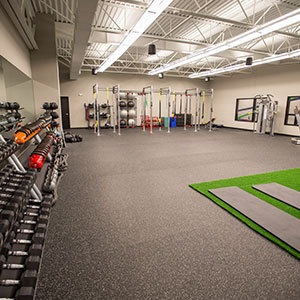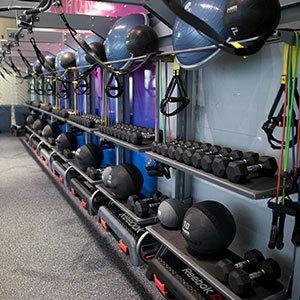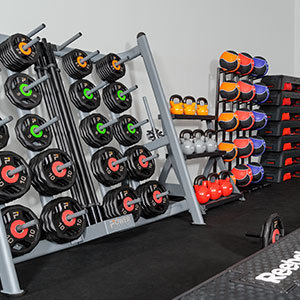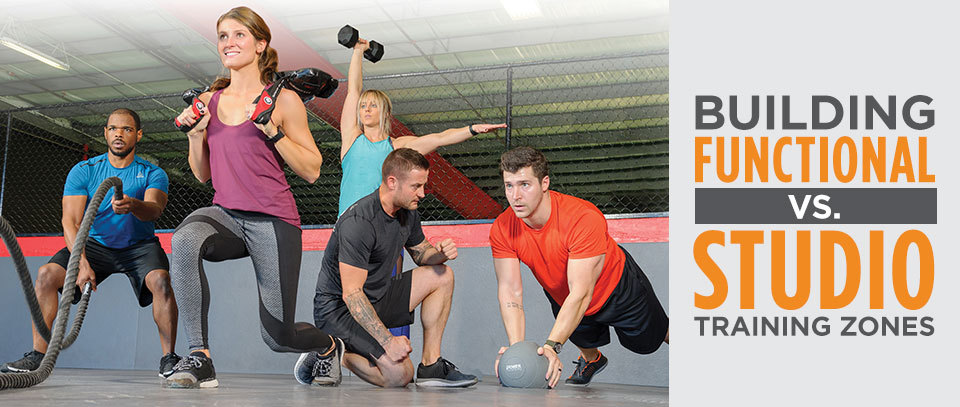Whether you are opening a new gym or renovating an existing facility, you will inevitability encounter the ‘Space Equation’. Once the four walls are up, the floor plan must be carefully executed to not only maximize the space, but to maximize the member experience. IHRSA contributor Jim Schmaltz has shed some light on the ‘space equation’ for health clubs,
“design and environment matter, and not just for safety/liability reasons. How you utilize space directly affects revenue and retention…”
The two most commonly used “R” words by every health club operator. He goes on to point out that,
“..today’s clubs don’t just have to accommodate multiple trends and equipment upgrades, they have to compete with the boutique aesthetic that’s become more commonplace in the industry.”
So, the question becomes, how can you showcase new or existing equipment while staying on pulse with exercise and programming trends, all while keeping aesthetics in mind? That seems a little overwhelming, so let’s break it down.
Establish Training Zones
Start by deciding the type and number of “training zones” you want to offer. According to IHRSA’s latest Health Club Consumer Report, the top three most utilized pieces of equipment by heath club members are treadmills, resistance machines, and free weights. That being said, when it comes to floor plan design or renovation, space for the “cardio and resistance training zones” should be allocated first.

How much space? Great question. According to ACSM’s Health/Fitness Facility Standards and Guidelines, the fitness floor should provide between 25 – 50 sq. ft. per piece of equipment on the floor.
Next, its time to tackle the open training spaces used for personal and group training. The group fitness or “studio training zones” are home to some of your most active and loyal members. Determine how many studio spaces you want to offer; and if the answer is more than one, decide if and how you want to differentiate them.
The “functional training zone” has the fastest growing footprint in facilities, by popular demand. Here, members can use accessory equipment such as kettlebells and stability balls or participate in one-on-one and/or small group training sessions.
Lastly, and we won’t go into much detail here, but it is worth mentioning; don’t forget to allocate space for “non-training zones”, i.e. locker rooms, common spaces, office space, retail space, etc. These are important to your members and to the overall success of your business.
Once you have separated your floor plan into “zones”, the next thing you will be excited to do is to fill these zones with all the equipment on your wish list. STOP! This next piece of advice will save you time and money!
Determine Zone Capacity
Before you go spending the entire equipment budget, do a few calculations to determine how much equipment you will need. The amount of equipment you need for the open “functional and studio training zones” will be determined by the amount of people you can comfortably fit in these spaces, aka “zone capacity”.
ACSM Health & Fitness Facility Standards & Guidelines recommends 40 – 60 sq. ft. per person in group training rooms. This might seem a bit conservative, but this space : person ratio will ensure a wide open and comfortable training space for all participants.

For example:
- 400 sq. ft – 4 – 5 people
- 600 sq. ft. – 8 -10 people
- 800 sq. ft. – 14 – 16 people
- 1000 sq. ft. – 20 – 22 people
Maximize the Space
One of the best ways to maximize the floor space in your designated “training zones” is with proper storage. One of the biggest design mistakes that health club owners make is not providing enough storage space. When training accessories are stored off the floor and/or against a wall, the space is maximized for movement. Proper storage solutions enhance the aesthetics of your open training spaces and minimize the clutter left on the floor or in corners.
Equipping the Zones
Functional Training Zone
The signature functional training equipment pieces are medicine balls, slam/dead balls, wall balls, kettlebells, battle ropes, plyo boxes, and suspension trainers.
The chart below will give you an idea of the most popular weight range for each of these pieces as well as the most commonly used weights within the range.
| Signature Piece | Popular Weight Range | Most Commonly Used Weights |
| Medicine Ball | 6 – 15 lbs. | 8 and 10 lbs. |
| Slam / Dead Ball | 10 – 35 lbs. | 10, 15, and 20 lbs. |
| Wall Ball | 8 – 20 lbs. | 10, 12, and 14 lbs. |
| Kettlebell | 15 – 70 lbs. | 25, 35, and 55 lbs. |
Battle Ropes or Training Ropes come in many sizes and lengths. Our best seller is the 40 ft. Power Training Rope with 1.5” grip.
When it comes to plyo boxes, our 3-in-1 plyo boxes are the best sellers because they feature 2 of the most popular training heights, 20” and 24”. However, it is good to have a few 12” or 18” plyo boxes available
for beginners to plyometric training.
Since the functional training zone will likely offer the most open space on the fitness floor, it is often utilized by members and during personal training sessions for warm up and flexibility exercises. It is a good idea to add some popular recovery pieces to your functional training zone such as:
- Foam Rollers – Our most popular for daily use on most muscle groups is the 36” round High Density Foam Roller.
- Massage Balls – As members get more and more familiar with body rolling techniques, some want to dive a little deeper by using a small surface area. Our most popular are the Muscle Knot Massage Peanut and the HighBaller.
- Mats – Our best mat for functional and recovery training is the 72” Premium Hanging Club Mat. The reinforced eyelets allow for hanging storage and the thickness of this mat is ideal for core and seated exercises.
Studio Training Zone
The signature studio pieces are dumbbells, cardio steps, stability balls, resistance tubes, BOSUs, cardio barbells/weighted bars, and mats.

- Dumbbells: Popular weight range 3 – 20 lbs. with 5, 8, and 10 lbs. most commonly used. 1 & 2 lbs. dumbbells are also popular for Barre and Senior strength classes.
- Stability Balls: Our best seller is the 55cm Versa Ball PRO. Order a few 65 cm stability balls as well to accommodate taller users over 6’ in height.
- Resistance Bands: The Medium resistance level is the most popular across our resistance tube family. Followed closely by Light and Heavy. Be sure to order some Extra Light resistance bands as well for beginners.
- Mats: The most popular length for a studio mat is 68”. For studio classes, both the club mat or the hanging club mat are great choices. If you want to supply mats specifically for yoga classes, our Manduka line has the perfect options.
- Cardio Barbell Sets / Weighted Bars: Many people prefer a cardio barbell set because it provides the ability to build the bar to an individual’s custom weight choice. It is also easy to change the weight of a cardio barbell to adjust for different exercises. The weight plates can also function as free weights. Our Cardio Pump Set is the most popular because of the grip “cutouts” in the plates as well as the beveled edge of the plate, keeps it from rolling away when not in use.
Weighted bars take up less space, but you lose the ability to customize the weight choice. Weighted bars also increase in circumference with the weight – heavier bars 15 lbs. and up are harder to hold on to due to the wide grip. Some people prefer weighted bars because it cuts down on the amount of equipment that must be carried back and forth to a station. Two bars (one light-moderate, one moderate-heavy) takes up less space on the floor than a cardio barbell set and a variety of weight plates.
Trust us, equipping training spaces is our specialty. We share in your excitement of opening or renovating a new training space. We have so much to choose from, far more than can be mentioned here, so feel free to browse the website or give us a call. We would love to talk with you about how to make the most out of your training zones!



You must be logged in to post a comment.